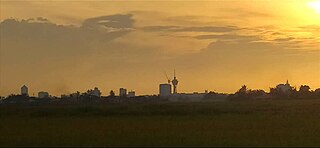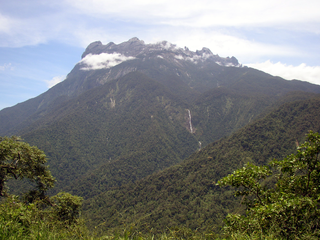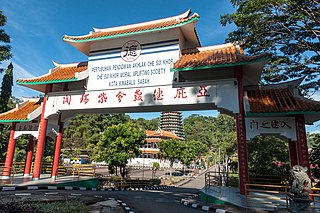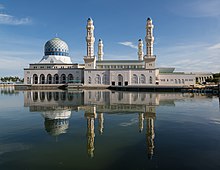
Kota Kinabalu, colloquially referred to as KK, is the state capital of Sabah, Malaysia. It is also the capital of the Kota Kinabalu District as well as the West Coast Division of Sabah. The city is located on the northwest coast of Borneo facing the South China Sea. The Tunku Abdul Rahman National Park lies to its west and Mount Kinabalu, which gave the city its name, is located to its east. Kota Kinabalu has a population of 452,058 according to the 2010 census; when the adjacent Penampang and Tuaran districts are included, the metro area has a combined population of 628,725. The 2020 Census revealed an increase in the municipal population to 500,421, while the wider area including the Penampang and Putatan districts had a population of 731,406.

Alor Setar is the state capital of Kedah, Malaysia. It is the second-largest city in the state after Sungai Petani and one of the most-important cities on the west coast of Peninsular Malaysia. It is home to the third-tallest telecommunication tower in Malaysia, the Alor Setar Tower.

Kinabalu Park, established as one of the first national parks of Malaysia in 1964, is Malaysia's first World Heritage Site designated by UNESCO in December 2000 for its "outstanding universal values" and the role as one of the most important biological sites in the world with more than 4,500 species of flora and fauna, including 326 bird and around 100 mammal species, and over 110 land snail species.

The Ranau District is an administrative district in the Malaysian state of Sabah, part of the West Coast Division which includes the districts of Kota Belud, Kota Kinabalu, Papar, Penampang, Putatan, Ranau and Tuaran. The capital of the district is in Ranau Town. The landlocked district bordering the Sandakan Division to the east until it meets the Interior Division border. Ranau sits 108 km (67 mi) east of Kota Kinabalu and 227 km (141 mi) west of Sandakan. As of the 2010 Census, the population of the district was 94,092, an almost entirely Dusun ethnic community.

Papar is the capital of the Papar District in the West Coast Division of Sabah, Malaysia. Its population was estimated to be around 124,420 in 2010, which is divided between Bruneian Malay, Kadazan-Dusun, and Bajau. There is also a sizeable Chinese minority, predominantly of the Hakka subgroup, as well as smaller numbers of other races. The town is located 38 kilometres south of the state capital of Kota Kinabalu, with the Papar railway station in the town becoming one of the main stops of the Sabah State Railway.

Sabah State Mosque is the state mosque of Sabah, located at Sembulan roundabout between Jalan Mat Salleh and Jalan Tunku Abdul Rahman in Kota Kinabalu, Sabah, Malaysia.

The Kota Kinabalu City Hall is the city council which administers the city and district of Kota Kinabalu in the state of Sabah, Malaysia. The council consists of the mayor plus twenty-four councillors appointed to serve a one-year term by the Sabah State Government.

Mukim Burong Pingai Ayer is a mukim in Brunei-Muara District, Brunei. It is located within Kampong Ayer, the traditional stilt settlements on the Brunei River in the capital Bandar Seri Begawan. The population was 1,770 in 2016.

Universiti Malaysia Sabah is a public university in Malaysia. It was officially established on 24 November 1994 as the ninth public university in the country. The university is located on a 999-acre site at Sepanggar Bay in Kota Kinabalu in the Malaysian state of Sabah. With Mount Kinabalu and the South China Sea as its background, UMS is often considered as among the most beautiful campuses in Southeast Asia.

Kota Kinabalu Wetland Centre is 24 hectares of the only remains of mangrove forest that once existed extensively along the coastal region of Kota Kinabalu, Malaysia. Previously known as Likas Swamp or Likas Mangrove and later Kota Kinabalu City Bird Sanctuary, the Centre came foremost out of 20 wetlands selected by the Sabah Wetlands Inventory Committee in 1986.

Cebagoo Football Club or Cebagoo is a Malaysian football club, based in Sepanggar, Kota Kinabalu, Sabah that formerly played in the Malaysia FAM League. After 2014 Malaysia FAM League season concluded, the club pulled from the league and focused on development of youth and grassroots program in Sabah.

Tun Pengiran Haji Ahmad Raffae bin Orang Kaya Pengiran Haji Omar was the second Governor of the Malaysian state of Sabah.

Tun Datuk Seri Panglima Sakaran Mohd Hashim bin Dandai was a Malaysian politician.

Pu Tuo Si Temple is a Buddhist temple located off Tuaran Road in Kota Kinabalu, Sabah, Malaysia. The temple was built in 1980 with a statue of Guanyin located in the entrance. It is the main Chinese temple for the city. In 2013, the temple received a total of RM115,000 from the federal government to finance its on-going renovation.

Che Sui Khor Moral Uplifting Society is a Dejiao establishment located in Kota Kinabalu, Sabah, Malaysia. The centre has been opened since 1981.

Jamek Mosque, officially Sultan Abdul Samad Jamek Mosque is one of the oldest mosques in Kuala Lumpur, Malaysia. It is located at the confluence of the Klang and Gombak River and may be accessed via Jalan Tun Perak. The mosque was designed by Arthur Benison Hubback, and built in 1909.

The Kota Kinabalu District is an administrative district in the Malaysian state of Sabah, part of the West Coast Division which includes the districts of Kota Belud, Kota Kinabalu, Papar, Penampang, Putatan, Ranau and Tuaran. The capital of the district is in Kota Kinabalu City.
Sabah Hakka Complex is a five-storey building complex with an event hall located at 26, Signal Hill Road, Tanjung Lipat, Likas of Kota Kinabalu, Sabah, Malaysia. The complex is built as a recognition from the Sabah government to local Hakka Chinese contribution to the economy of Sabah since their early migration with the main building structure is designed after the world-famous traditional Hakka houses in Fujian of China, the Tulao.
The COVID-19 pandemic was confirmed to have reached Sabah, Malaysia, in March 2020. As of 16 November 2022, there are 402,031 confirmed cases.























